The Imperial City of Hue - always alive!
So far, The Imperial City of Hue remains to be the only original historical vestige city in Vietnam. Many of Hue’s attractions are found along the banks of the romantic Perfume River with the length of 11km.
The imperial monuments of Hue, by their original destination, by their tumultuous and massacring history, by their inscription on the Unesco World Heritage List, seem a little embalmed, mummified by the patrimonial respect. There is some truth in this, but they are not reduced to it. They do not want to see them die, even surrounded by cultural devotion. Therefore, Hue - always alive!
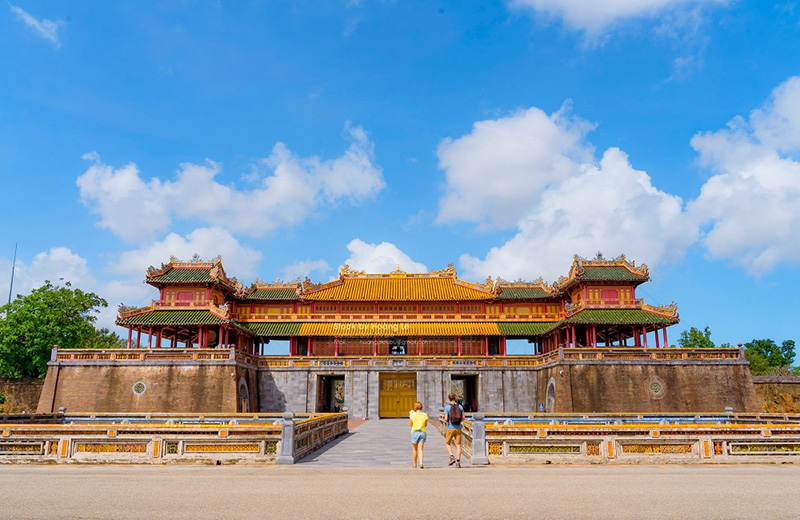
Hue - always alive!
The head of the empire
Let us first take a little altitude, in order to realize that Hue - the capital of the Nguyen dynasty, from the beginning of the 19th century to the end of the Second World War - is not only a river city, but a riverine one. It is established in a meander of the Perfume River, which flows towards the sea with an ambiguous nonchalance. The imperial citadel is camped on the left bank, where diversions and canals multiply, rectilinear on the periphery, festooned by bastions and curtain walls on the outskirts of the fortress. Reservoirs, basins, lakes add additional shimmering. The rhythm of all this reveals a sophisticated conception. Fluidity and resistance, curves, straight lines, angles, nature and artifice make up a truly royal ensemble. A consequent power must make manifest its mastery of earth and water. It is the latter that manifest, when the time comes, the exhaustion of dynastic virtue. The site of Hue speaks in favor of the legitimacy of the Nguyens. Let us note, on the right bank, the city developed around the French establishment. Two empires are being measured against each other, linked by the Trang Tien bridge, ex-Clémenceau, built between 1897 and 1900 by Schneider et Cie. Let's go back to the floor of the rickshaws.
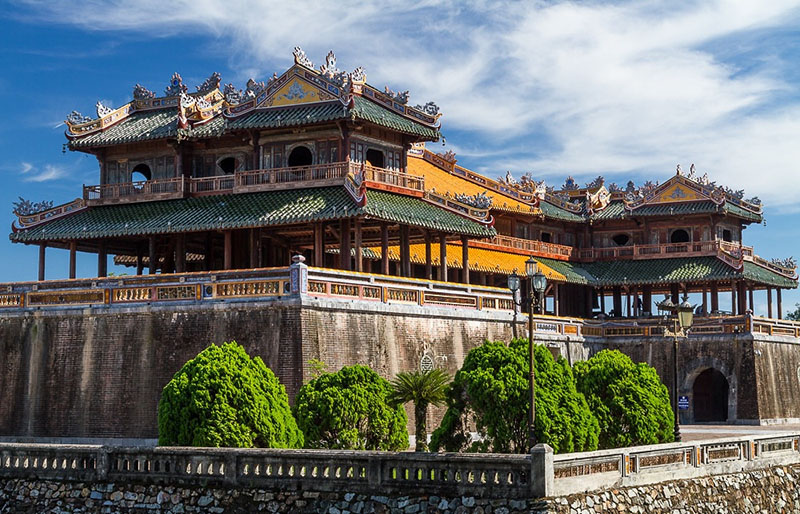
Hue capital
From the middle of the bridge, where to start? By the most Vietnamese perhaps. And the most universal, since Unesco has registered the old Hué as a world heritage site. It is necessary to be a little didactic at the risk of not finding oneself there. The citadel - Kinh Thành, contains the imperial city - Hoàng Thành, and the forbidden purple city - Tu Cam Thành. Vietnam had not inherited Confucianism and the imperial system from China for nothing. The citadel housed the organs of the administration; the imperial city, the podiums of the Presence; the purple city, the sovereign's private residence. Ten bridges and ten gates give access to this sovereign compound. The traveler today enters through the impressive South Gate. In the shape of a horseshoe, it has a masonry base and wooden superstructures with glazed tile roofs.
The symbolism of power is expressed in the geometry, the colors and the motifs of the building. Turning around, we see the red flag with the yellow star flying above the Flag Tower. Let's enter and head for the Palace of Supreme Harmony, on whose roof two dragons greet the moon. Behind it, the Forbidden City opens, or rather closes. Let us go all the same, towards the royal library, miraculously intact. The geniuses of the roof will have protected this delightful pavilion. In 1968, during the battle of Hue in the Tet offensive, the private domain of the emperors was devastated by the fighting. Restorations meticulously recovered what could be restored, but priceless treasures were lost forever. And it is not without a certain melancholy that one notices the empty spaces.
Mausoleums and pagodas
The imperial mausoleums are another aspect of the historical buildings of Hue. There are seven of them along the river. Among these funerary villages, three perhaps stand out. Eight kilometers from the citadel, that of Tu Duc. Empty. It is not known where the emperor's body was buried. There is something romantic about this large wooded estate where the gray stone buildings have a particular sobriety and harmony. At the edge of a lake, the Xung Khiem leisure pavilion is full of charm. The Stele pavilion contains a colossal stone to the glory of the monarch. To the north of the domain, on Mount Duong Xuan, the Tu Hieu pagoda was commissioned by the eunuchs of the imperial city (without a son to look after them post mortem, they entrusted themselves to the monks). Ten kilometers away, the tomb of Khai Dinh mixes Vietnamese architecture and Beaux-Arts style. A fusion that recalls the adaptations of classical models that the Jesuits made in China. The tomb hall is of stunning ornamental virtuosity. Accessible by river - some 20 kilometers - the burial complex of the dynasty's founder, Gia Long, stretches across a series of hills. The members of his family rest around him. He reigns in death as in life.
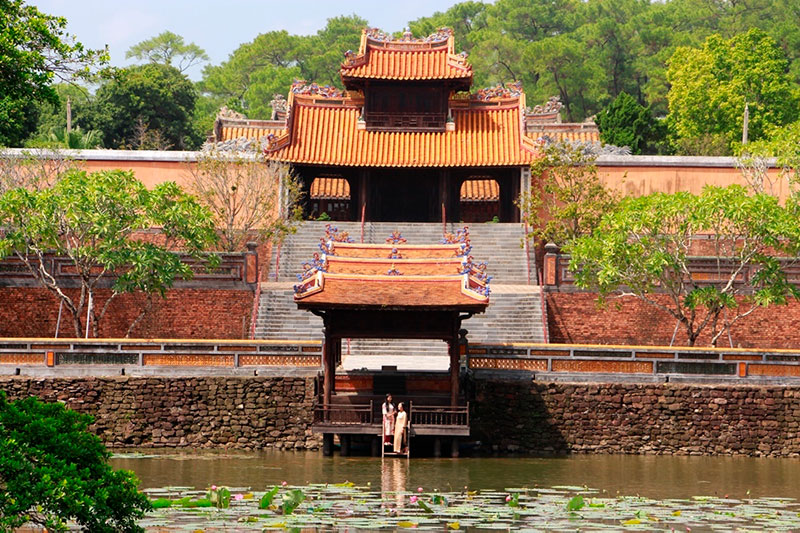
Tomb of Tự Đức , officially Khiêm Mausoleum
The dragon boats that go on the Perfume River to take tourists for a ride are delightfully kitschy. On board these boats, one can go to the pagoda of the Celestial Lady - Thiên Mu Pagoda three kilometers west of the citadel. It majestically dominates the river from the top of Hà Khê hill and its own 21 meters. Founded in 1601, regularly refurbished since then, it has today the octagonal shape and the seven levels given to it by Emperor Thiêu Tri in 1844. The monks have resisted both the authoritarianism of Ngô Dinh Diêm and communism. The Tu Dam pagoda, less known to travelers, which can nevertheless be reached on foot without effort from the citadel, is a beautiful Thiên foundation of 1695 which still attracts many pilgrims. The mountainous backgrounds give to all these monuments a particular base and relief.
A great culinary tradition
The cuisine of Hué is particularly renowned as the heir to the imperial table. It was not a question of serving sloppy and repetitive dishes to the monarchs. The art of the table is therefore practiced here with particular care, freshness and variety. In the staging of the dishes, this goes as far as theatricality. The vegetables sometimes become spectacular sculptures. We no longer serve peacock egg rolls, bear's paw, or even swallow's nest soup. However, the variety of recipes makes up for these reasonable renunciations. We like the nem, spicy minced pork on a lemongrass stick, with raw vegetables and aromatic herbs. The banh bèo, cups of rice dough, filled with shrimp and pork skin, fish sauce. Or banh bôt loc, tapioca ravioli. Etc.
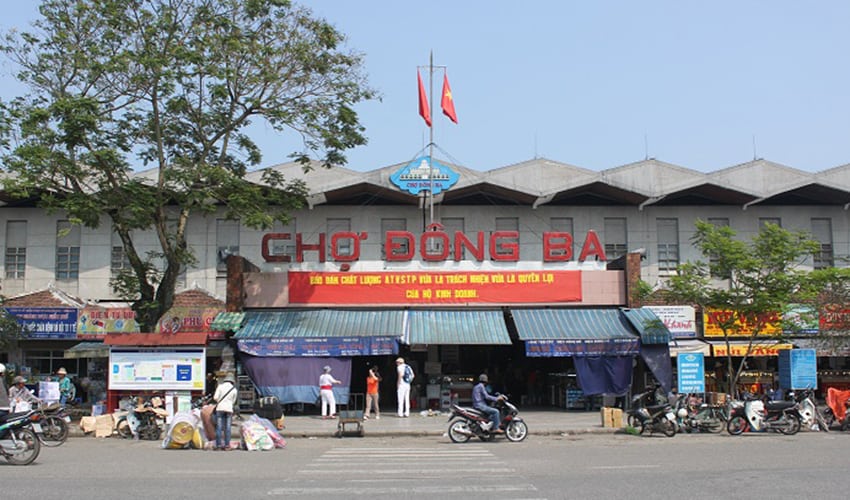
Dong Ba market
Imperial cuisine is recreated by passionate chefs and offered on special occasions, but street food itself benefits from the attention paid to the things of gastronomy (which have a dietetic dimension, it goes without saying). So it is everywhere in Hue that one can enjoy, from posh restaurants to street stands. To go to the source of the ingredients, you must go to the market of Dong Ba. For it is there that, in all their crudeness and colors, one finds the most. The number of goods on offer, which a European would not know what to do with, can lead him to measure the richness and unpredictability of the gastronomy here. The fish market is a market within a market, which opens at three in the morning. The boats come to the quay to deliver their catch.
From the sea to Hue
Early in the morning, you have all the time in the world to ride your bicycle through the countryside, perhaps for more down-to-earth impressions, less marked by aristocratic pomp. Until, for example, the picturesque village of grapefruit trees. Or the Japanese covered bridge of Thanh Toan. Since 1776, it draws a graceful curve over the water. Dragons play on its tiled roof and an altar dedicated to its founder occupies the central platform. Once again, the idea is to interest passers-by in the posthumous destiny of a person who died without descendants. Of a completely different spirit is the Hô Quyên arena in Truong Da village. This beautiful ring-shaped brick building was built in 1830 to host elephant and tiger fights. It would have been a question of training the pachyderms to war. In order not to jeopardize such a costly military investment, they would have been confronted with blunt tigers. This is really not fairplay. About ten kilometers from Hué, there are beaches. Like the long, flat, golden and free Thuan An. To the north of this one is the Tam Giang lagoon, a vast horizontal landscape that is an important biodiversity issue. Programs are underway to protect its ecological and economic interests. Birds are numerous there.
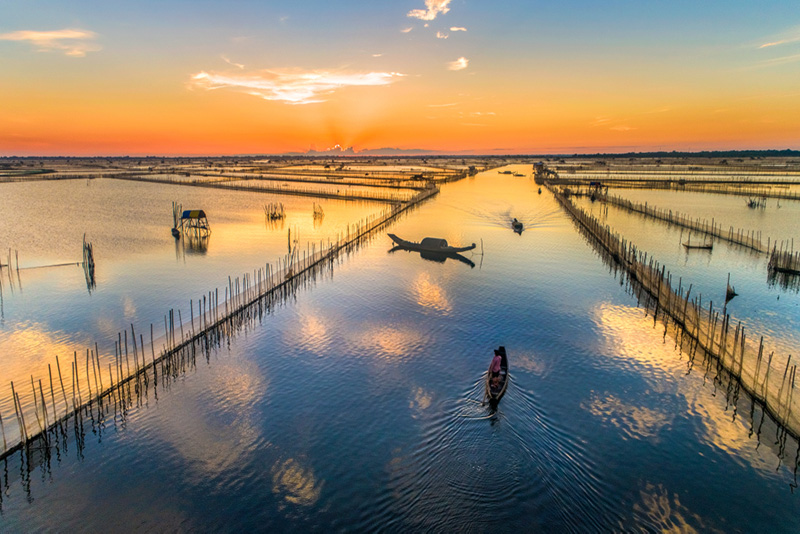
Tam Giang lagoon
Back in Hue, we must focus on the right bank, the French sector. The layout of a 3rd Republic provincial city still stands out. Thus the raspberry station from 1906, stop of the Transindochinois from the 1930s. The old Grand Hotel dates from 1901, it is still in business and still immaculate. The national school has cinnabar walls, which were raised during the Great War. And as a proof that education does not formate so much, it had Ngô Dinh Diêm and Hô Chi Minh as students. The villas in which the cultural museum is located harmonize European pleasure architecture and Vietnamese motifs. As for the hotel La Résidence of 1930 and the sports circle - ten years later - they are beautiful examples of Art Deco liner architecture. And then, of course, there is the Tràng Tiên Bridge.
Finally, two strange visions
First, the water park of Thuy Tiên Lake. Opened in 2004, then closed for lack of results. Since left to the abandonment. It is an inglorious ruin but full of picturesque in which one walks freely. The vegetation gains on the installations which are dilapidated little by little. Entertainment and leisure do not always win the day or, paradoxically, the failed park attracts more than the triumphant park. The huge dragon on the lake seems to be lost, distraught. One can climb into its mouth to get a view.

The water park of Thuy Tiên Lake
An Bang, about thirty kilometers southeast of Huê, also has a cemetery, Nghia trang An Bang, but it is something else. People are buried there in monuments that seem by their size, their vertical abundance, their polychromy, the volubility of their ornamentation, perfectly extravagant. A city of the dead imagined by some Vietnamese Druillet. A powerful optimism emerges from this. A confidence. The same confidence that the emperors used to show in their funeral villages.
Source: voyageursdumonde
Articles same category
Yearly festivals in Vietnam
With many activities taking place such as singing and dancing, boat racing, street parades, etc., creating special features for festivals in Vietnam.
15 activities to discover Sapa for foreign tourists
You are about to have a trip to Sapa in Vietnam, and here are the 15 most interesting Sapa discovery activities for you.
Discover the Top 4 most beautiful idyllic fishing villages in Ha Long
You will have moments of being immersed in the idyllic life of the people of the fishing villages.







_w100_h80_c.jpg)

_w100_h80_c.jpg)